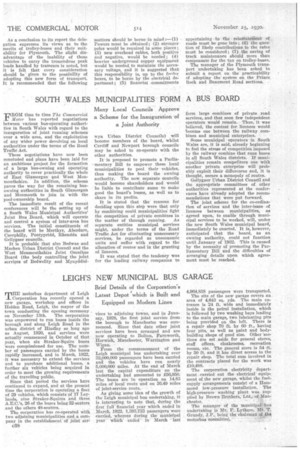PLYMOUTH'S EXAMINATION OF THE TROLLEY-BUS
Page 59

Page 60

If you've noticed an error in this article please click here to report it so we can fix it.
Features of the Wolverhampton, Nottingham and Hastings Systems Which Have Been Inspected by the Municipality SOME interesting details of the trolley-bus systems in operation at Wolverhampton, Nottingham and Hastings have been collected by some members of the Plymouth Corporation and rnentiOned in a report on the advisability of instituting trolley-bus services in Plymouth.
The report states that Wolverhampton is noted as the first town of any size, to abolish its tramways, substituting trolley-buses and motorbuses. The authority there has running powers outside its own boundaries, and is able to serve.:: many small commithities away from the centre of Wolverhampton. Probably the essential reason for this early action in Wolverhananton was the fact that, in 1922, it became apparent that 2+ miles of tramway track was worn out. rt was decided in substitute a trolley-bus service on this particular route, and it was found in doing so that, after paying a substantial amount towards the reconstruction of the rosid, the cost of introducing the new system was about half the cost of laying the new track.
Wolverhampton had an outstanding tramway debt in 1920 of £140,000; 10 years were allowed to pay it off, but it was paid off in six years. Features of the system are the reinforcement of the medium-weight poles to carry the heavier wires necessary for trolley-bus duty, the agreement of a figure of 7s, per square yard, for reinstated roads, although the estimate was 4s., and the obtaining of electricity supplies from two sources, enabling the system to maintain a fairly constant voltage and rendering unnecessary the laying of heavier underground cables to care for
the increased power required. The cost of electricity is approximately id. per unit, fares being dearer than they are in Plymouth. The trolley-bus tax bears comparison with the cost of tramway-track maintenance and rates are payable as with the tramway system. The double-deckers carry 65 Persons.
In connection with Nottingham, the report mentions that the trams there were remarkable for the noise they set up, and it is no wonder why the local committee turned its attention to an alternative transport means. The manager of the Nottingham services referred to the necessity of bearing in mind the future possibility of the Diesel engine, but said that the trolley-bus system was greatly appreciated by the public. In this-caSe, the tleet eOmpriSes 24 vehicles, including a number of six-wheelers, with a capacity for 65 passengers. The poles
of the tramway system litive been reinforced to take the extra weight, the underground copper that fed the tramway having proved adequate, and an important factor is that the electrical department is responsible for the upkeep of underground equipment up to the feed boxes.
The financial position is one to be envied. Up to last year the,department has contributed .£24,000 annually to the rates, but this has been diScontinued. The vehicle loan is spread over 10 years, and the overhead-equipment loan is spread over 15 years, motorbuses being paid for in five years. The working expenses 'per vehicle-mile are: trams 12.7d., trolley-buses 11.83d., motorbuses 10.51d., the revenue being :—trams 15.5d., trolley-buses 17.25d., 'motorbuses 12.1d.
During its visitto Nottingham the delegation from Plymouth travelled on Guy, Ransomes, A.E.C. and other vehicles. In connection with this system the outstanding franiwayS debt waa £300,000, the outstanding debt for track and overhead equipment being fl.17,000. The tram-route mileage is 46 and the trolley-bus route is seven miles tong. No pressure has been brought as to road reinstatement, an agreement of 5s. 6d. per sq. yd., having been inacle.
In Hastings, the report explains, the transport ''ystem is run by private enterprise, and the trams have been completely substituted by trolley-buses, single-deckers with central entrance being first employed, and double-deckers being afterwards introduced. In Hastings the gradients are similar to those in Plymouth, and trolley-buses take them in their stride at about 15 m.p.h. 13ranch. lines of the overhead equipment, known as " throw-backs," are placed at various points along the route, enabling a vehicle to leave the route, thereby releasing the traffic immediately behind it. It is understood that an agreement ha s^ been reached between the council and the company whereby the authority will reinstate the roads at a charge of 3s. 5d. per sq. yd., a period of four years being allowed for payment..
The Plymouth Corporation members also paid a visit to the depot of London 'United Tramways, Ltd., at Enlwell, and there saw the latest of six-wheeled trolley-buses operating with a specially constructed overhead equipment. This company has • obtained Parliamerrtary powers to substitute trolley-buses for trains in -certain localities.
As a conclusion to its report the delegation expresses its views as to the merits of trolley-buses and their suitability for Plymouth. The slight disadvantage of the inability of these vehicles to carry the tremendous peak loads handled by tramcars is noted, but it is felt that every consideration should be given to the possibility of adopting this new form of transport. It is recommended that the following
matters should be borne in mind :—(1) Powers must be obtained; (2) stronger poles would be required in some places ; (3) new overhead cables, both positive and negative, would be needed ; (4) heavier underground copper equipment would be needed, to maintain the necessary voltage, and it is suggested that this responsibility is, up to the fcpcior boxes, to be borne by the electric-al department; (5) financial .commitments
appertaining, to the reinstatement of roads mast be gone into ; (6) the question of likely contributions to the rates must be considered; (7) the saving of track maintenance should more than compensate for the tax on trolley-buses.
The manager of the Plymouth transport undertaking has been asked to submit a report on the practicability of adopting the system on the Prince Rock and Beaumont Road sections.












































































































